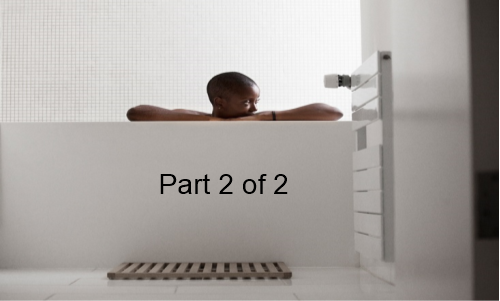I was gripped with fear and terrified that I was going to drown and that my family would be the ones to find me in this state.
I imagined family members blaming themselves for not being there to save me, so I decided that I couldn’t go.
I closed my eyes and started breathing deeply and slowly and I began to visualise being able to move my left arm to reach the chain attached to the bath plug.
When I could eventually feel the chain, it took a while and every bit of focus to hook my finger around the chain, pulling the plug out from the plughole- allowing water to start draining away.
Listening to water draining away was emotionally overwhelming. I cried with joy but it wasn’t over yet…
I still hoped that the water would drain away quicker than the rate that I was still sliding under.
At last, I was lying in an empty bath tub-now cooling to the point that I felt quite cold and as my body temperature dropped, I was able to move my limbs and wiggle my fingers and toes again.
I lay in an empty bath, suffering from shock but thanking my spirit guide for keeping me company while I worked out my survival plan.
When I eventually got out of the bath and out of the bathroom, my husband couldn’t get a proper sentence out of me.
So what was actually happening during this time?
Known as: Heat Intolerance, Temperature or Heat sensitivity
There is a part of the brain called the hypothalamus which is responsible for controlling your body temperature, keeping it at the right temperature in hot or cold conditions. It does this by sending signals to the body to start sweating if it gets too hot, or shivering if it gets cold.
For those who have an existing medical condition, the hypothalamus does not work as well as it should and so may not be able to regulate the body so easily.
Many people enjoy warmer temperatures, but some people with autoimmune or neurological conditions such as; Hypothyroidism, Multiple Sclerosis, Fibromyalgia and Parkinson’s to name a few have problems in the heat.
Difficulties regulating body temperature can be a serious issue for this group of people because the heat can stop nerve fibres from working properly. This means that sometimes messages cannot get through to from the brain leaving sufferers to experience fatigue, weakness, difficulty breathing and problems with balance or vision.
These symptoms compromise safety and may create dangerous situations similar to the one I had.
But after almost a decade of avoiding the bath tub, I decided that with careful planning and now with a better understanding, I could return to having an occasional soak in the bath.
What are the things I do or use that make bath time safe again for me?
1 ) Use a rubber suction bath mats (reduces ability of slipping or sliding down in the bath tub
2 ) Position of plughole –
Ensure that the chain is securely connected to the plug and that you can usually reach this easily if required.
The plug hole being positioned in the middle of the tub instead of at the head or tail was a saving grace.
3 ) I keep a container of ice cold water next to me on the rim of the bath and drink this as soon as I begin to feel that I’m overheating.
4 ) On the very few occasions that I decide to have a soak in the bath, I don’t lock the door.
Thank you for reading my article

